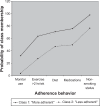Is there a nonadherent subtype of hypertensive patient? A latent class analysis approach
- PMID: 20694185
- PMCID: PMC2915558
- DOI: 10.2147/ppa.s11335
Is there a nonadherent subtype of hypertensive patient? A latent class analysis approach
Abstract
To determine subtypes of adherence, 636 hypertensive patients (48% White, 34% male) reported adherence to medications, diet, exercise, smoking, and home blood pressure monitoring. A latent class analysis approach was used to identify subgroups that adhere to these five self-management behaviors. Fit statistics suggested two latent classes. The first class (labeled "more adherent") included patients with greater probability of adhering to recommendations compared with the second class (labeled "less adherent") with regard to nonsmoking (97.7% versus 76.3%), medications (75.5% versus 49.5%), diet (70.7% versus 46.9%), exercise (63.4% versus 27.2%), and blood pressure monitoring (32% versus 3.4%). Logistic regression analyses used to characterize the two classes showed that "more adherent" participants were more likely to report full-time employment, adequate income, and better emotional and physical well-being. Results suggest the presence of a less adherent subtype of hypertensive patients. Behavioral interventions designed to improve adherence might best target these at-risk patients for greater treatment efficiency.
Keywords: adherence; hypertension; latent class analysis; self-management.
Figures
References
-
- Fields LE, Burt VL, Cutler JA, Hughes J, Roccella EJ, Sorlie P. The burden of adult hypertension in the United States 1999 to 2000: A rising tide. Hypertension. 2004;44(4):398–404. - PubMed
-
- The ALLHAT Officers and Coordinators for the ALLHAT Collaborative Research Group Major outcomes in high-risk hypertensive patients randomized to angiotensin-converting enzyme inhibitor or calcium channel blocker vs diuretic: The Antihypertensive and Lipid-Lowering Treatment to Prevent Heart Attack Trial (ALLHAT) JAMA. 2002;288(23):2981–2997. - PubMed
-
- Psaty BM, Lumley T, Furberg CD, et al. Health outcomes associated with various antihypertensive therapies used as first-line agents: A network meta-analysis. JAMA. 2003;289(19):2534–2544. - PubMed
-
- Chobanian AV, Bakris GL, Black HR, et al. The Seventh Report of the Joint National Committee on Prevention, Detection, Evaluation, and Treatment of High Blood Pressure: The JNC 7 report. JAMA. 2003;289(19):2560–2572. - PubMed
-
- Elmer PJ, Grimm R, Jr, Laing B, et al. Lifestyle intervention: Results of the Treatment of Mild Hypertension Study (TOMHS) Prev Med. 1995;24(4):378–388. - PubMed
Grants and funding
LinkOut - more resources
Full Text Sources
Medical


